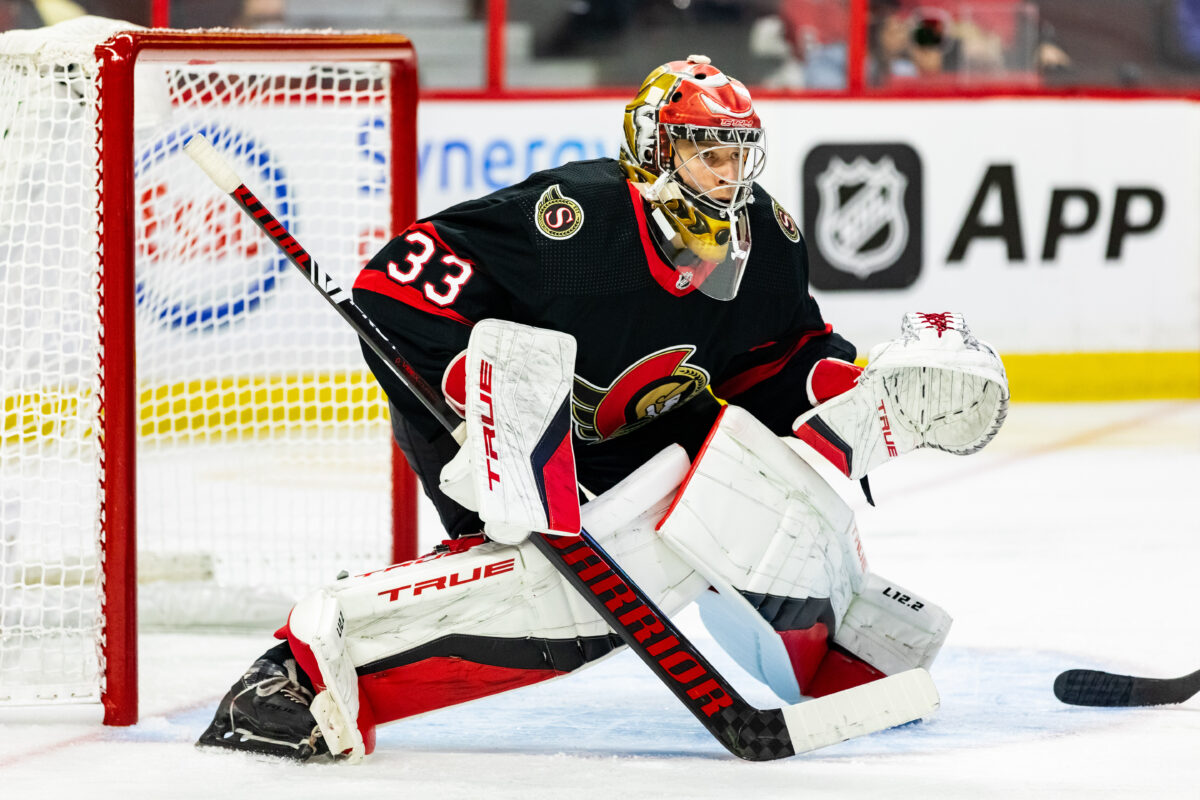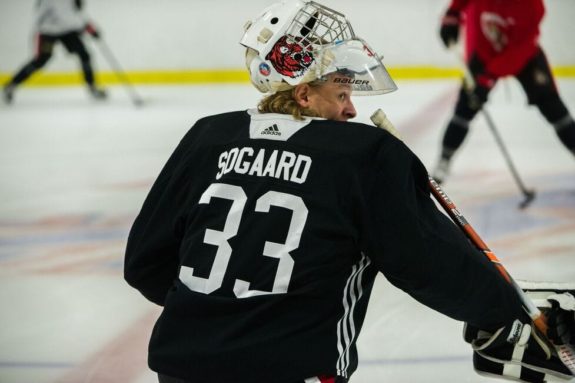The Ottawa Senators debuted rookie goaltender Mads Søgaard in their win against the Detroit Red Wings on April 1, 2022. In his first NHL start, he proved he was no fool facing 29 shots, allowing two goals and finishing the night with a .931 save percentage (SV%). The win keeps the Senators barely in the playoff picture. Here’s some more info on the aptly nicknamed “Great Dane” and how his first NHL win played out.
Who is “The Great Dane”?
With the playoff window nearly shut for the team, the Senators are giving some of their prospects NHL experience. Stacking up at a staggering 6-foot-7, Søgaard’s size has been the focal point for much of his hockey career. After Anton Forsberg and Filip Gustavsson, he is next in line for the crease in Ottawa. Prior to Friday night’s tilt, he backstopped the majority of games for the Senators’ American Hockey League (AHL) affiliate, the Belleville Senators.
Related: 4 Senators Prospects to Watch as the Regular Season Ends
Starting in 31 of their 57 games this season, he holds a .906 SV% and a 2.87 goals-against average (GAA). Søgaard is 12th in the AHL for shots against and therefore is facing a relatively high workload compared to his peers. Ranking at 28th in GAA and 21st in SV%, his performance so far in the AHL has been rather middle-of-the-pack.

Hailing from Aalborg, Denmark, Søgaard played for a variety of Danish junior teams and represented his country at international tournaments before moving to the United States to play for the Austin Bruins of the North American Hockey League (NAHL), the tier two junior league in the US. Selected 32nd in the Canadian Hockey League (CHL) import draft, he signed on with the Medicine Hat Tigers where he played before and after being taken by the Senators in the second round of the 2019 NHL Draft. After the draft, the big netminder returned home to play for the Esbjerg Energy in Denmark’s highest-tier league. At the conclusion of their season, he returned to Canada to suit up for the Belleville Senators.
Poised and Patient, but Room to Grow
In his first NHL start, Søgaard showed why he was selected in the second round. In the first period, he looked immediately at home, standing tall with confidence. In a period defined by the Senators’ play, the rookie faced minimal shots but held strong on a few dangerous chances. His ability to track the play with very active head movement was immediately noticeable. The Red Wings were not able to apply continued pressure, but Søgaard quickly stifled the scoring chances they did have by locking in and staying square to the shooter.
The second period highlighted the main fault in Søgaard’s game: his recovery. The Red Wings capitalized on an outlet pass that led to Lucas Raymond and Jake Walman taking control of the neutral zone and entering with speed. He caught Walman’s shot but immediately bobbled it. When the puck dropped in the crease, he was unable to locate it as Raymond closed the gap and poked it in. Throughout the game, Søgaard had difficulty recovering after the initial shot attempt. He tracked the developing play well but struggled to reposition after dropping to the butterfly. Aptly nicknamed “The Great Dane”, his height should be a strength, but like Ben Bishop and Mikko Koskinen before him, he needs to lock in his transitional play to have consistent success in the NHL.
Settling Into the Crease
The Red Wings came into the third period with a five-on-three powerplay. Søgaard stood tall as the Wings took a penalty to set the game to four-on-four. The first half of the period was not overly busy for the Danish netminder until Detroit made a bold decision and pulled their goalie with just over six minutes remaining. On the ensuing rush, Raymond tipped the puck from just outside the crease, narrowly putting it into the net. The Red Wings got the extra man again with just over four minutes remaining, but Søgaard ended up finishing the game without allowing another goal.

Overall, Søgaard looked at home in his first NHL start where he became the third youngest goalie to win a game for the Senators, behind Robin Lehner and the late Ray Emery. With a number of goalies in the system capable of playing at the NHL level, there isn’t room for him yet, but with another year or two of development at the AHL level, he should have a good shot of playing consistently for the Senators in the future. Although the playoff picture is quickly closing, Senators fans still have a lot to look forward to. The 15 games remaining should highlight the level of talent in the prospect pool and make one thing clear: the future in Ottawa is bright.